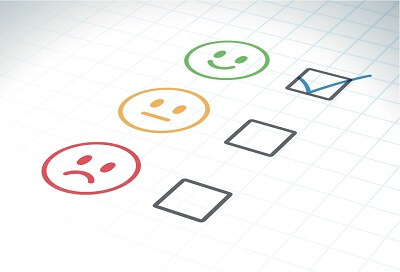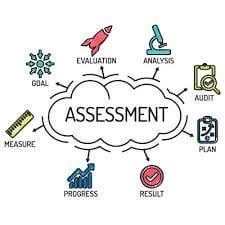Assessment DefinitionWhat is Assessment?Assessment is critically important in any educational system, providing valuable feedback to instructors and students. By providing detailed information about a student's performance, the assessment allows instructors to identify areas of strength and weakness, tailor instruction to meet individual needs, and measure progress over time. Likewise, students can use assessment results to pinpoint their areas of success, identify areas for improvement, and compare their progress against established goals. As such, assessment is an invaluable tool for instructors and students, making it an integral part of any educational system. 
Assessment is "the process of gathering and evaluating evidence to make decisions about learning." It is a systematic process that involves gathering evidence about student performance, interpreting it, and then deciding what it indicates. Assessment can take many forms, from paper-pencil tests and quizzes to project-based activities and group assignments. Each assessment form is designed to measure specific learning outcomes and provide feedback to instructors and students. Purpose of AssessmentThe primary purposes of assessment are to document student progress and to inform instruction. By providing detailed information about a student's performance, the assessment allows instructors to tailor instruction to meet individual needs and measure progress over time. Likewise, students can use assessment results to pinpoint their areas of success, identify areas for improvement, and compare their progress against established goals. For assessment to be effective, it must be both valid and reliable. Validity refers to the accuracy and appropriateness of the assessment instrument. For an assessment to be valid, it must measure what it is intended to measure. Reliability refers to the consistency of the assessment instrument. For an assessment to be reliable, it must produce the same results when used multiple times. The assessment also must be aligned with learning objectives. Learning objectives provide a clear roadmap for what students should be able to do at the end of the course. The assessment instrument must be designed to measure the mastery of these objectives to provide accurate and meaningful feedback. In addition, assessment must be equitable and accessible. Equitable assessment means all students are given the same opportunities to demonstrate their learning. Accessible assessment means that all students have reasonable access to the assessment instrument and the necessary support to complete it. Assessment must be used as part of a larger system of feedback. Assessment results should be used to inform instruction and guide student progress. This feedback loop is essential for helping students reach their goals and for providing instructors with valuable information about their students' performance. Assessment is an invaluable tool for instructors and students, making it an integral part of any educational system. When the assessment is used properly, it can be invaluable in helping instructors and students reach their goals. Advantages and Disadvantages of AssessmentThe advantages of assessment include providing meaningful feedback to both instructors and students, allowing instructors to tailor instruction to individual needs, and allowing students to evaluate their performance. The assessment also has the potential to provide a better understanding of the learning process and can be used to measure student progress over time. 
However, the assessment also has some potential drawbacks. For example, assessment results can be misused or misinterpreted, leading to misunderstandings or incorrect conclusions. Assessment can be time-consuming and expensive, particularly when administering more complex assessment tools. Finally, assessment methods can be subject to bias or be limited in their ability to measure certain learning objectives accurately. It is important to ensure that assessment methods are valid, reliable, and aligned with learning objectives to maximize assessment benefits while minimizing potential drawbacks. Assessment should also be equitable and accessible and part of a larger feedback system. When the assessment is used properly, it can be invaluable in helping instructors and students reach their goals. Countries With the Best Assessment SystemRegarding assessment systems, several countries stand out as having some of the best in the world. These countries have implemented systems to ensure the best outcomes for their students, teachers, and educational institutions. The United States is one of the countries with the best assessment systems. The United States has a long history of assessment systems, first adopting standardized tests such as the SAT in 1926. Since then, the United States has developed various assessment systems used in classrooms and for high-stakes tests. These systems include the Common Core State Standards, which assess students in reading and mathematics, and the Next Generation Science Standards, which assess students in science. In addition, the United States also has a strong history of assessment for college admissions, with the ACT and SATs being widely used. The United Kingdom is another country with an excellent assessment system. The UK has long used a system of national tests, including the GCSE and A-Level exams, to measure a student's academic achievement. In addition, the UK also has a strong system of formative assessment, which is used to monitor student progress throughout the year. This formative assessment takes the form of classroom tests and assignments designed to assess a student's understanding of a subject and inform instruction. Another country with an excellent assessment system is Finland. Finland has a long history of using assessments to measure student achievement and inform instruction. Finland is well known for its focus on student-centred learning, supported by a rigorous assessment system. This system includes the National Assessment of Educational Progress, used to measure student achievement, and the Finnish National Examinations, used to assess student performance in core subjects. Finally, Singapore is another country with an excellent assessment system. Singapore has developed a formative and summative assessment system closely linked to its national curriculum. This system includes a range of tests and assessments used to measure student progress and a high-stakes exam, the Primary School Leaving Examination, used to determine secondary school eligibility. There are several countries with excellent assessment systems. The United States, the United Kingdom, Finland, and Singapore are just a few examples of countries that have implemented systems designed to ensure the best outcomes for their students and educational institutions. 
Role of Teacher in AssessmentsThe role of a teacher in assessments is essential in the learning process. Assessments are important for teachers to evaluate student learning and provide feedback. Through assessments, teachers can measure student understanding, identify areas of strength and weakness, and adjust instruction accordingly. Assessments can also track student progress, set learning goals, and motivate students to strive for success. Assessments can be formal or informal and take many forms, including standardized tests, quizzes, projects, and presentations. Some Examples of Assessments
ConclusionAssessments are crucial for teachers to measure and give input on their students' learning. Standardized exams, quizzes, assignments, and speeches are just a few assessment methods. Assessments are used to gauge pupil comprehension, pinpoint strong and weak areas, and modify teaching as necessary. Additionally, assessments can be used to establish learning objectives, monitor students' growth over time, and inspire them to work hard.
Next TopicCube Definition
|
 For Videos Join Our Youtube Channel: Join Now
For Videos Join Our Youtube Channel: Join Now
Feedback
- Send your Feedback to [email protected]
Help Others, Please Share










